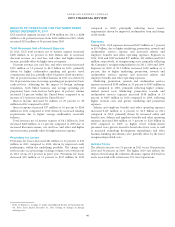American Express 2011 Annual Report Download - page 51
Download and view the complete annual report
Please find page 51 of the 2011 American Express annual report below. You can navigate through the pages in the report by either clicking on the pages listed below, or by using the keyword search tool below to find specific information within the annual report.AMERICAN EXPRESS COMPANY
2011 FINANCIAL REVIEW
Interest income — Interest income includes (i) interest and fees
on loans, (ii) interest and dividends on investment securities and
(iii) interest income on deposits with banks and others.
Interest and fees on loans includes interest on loans, which is
assessed using the average daily balance method for owned loans.
Unless the loan is classified as non-accrual, interest is recognized
based upon the principal amount outstanding in accordance
with the terms of the applicable account agreement until the
outstanding balance is paid or written off. Loan fees are deferred
and recognized in interest income on a straight-line basis over
the 12-month card membership period, net of deferred direct
card acquisition costs and a reserve for projected membership
cancellation.
Interest and dividends on investment securities primarily
relates to the Company’s performing fixed-income securities.
Interest income is accrued as earned using the effective interest
method, which adjusts the yield for security premiums and
discounts, fees and other payments, so that the related
investment security recognizes a constant rate of return on the
outstanding balance throughout its term. These amounts are
recognized until these securities are in default or when it is likely
that future interest payments will not be made as scheduled.
Interest income on deposits with banks and other is recognized
as earned, and primarily relates to the placement of cash in
excess of near-term funding requirements in interest-bearing
time deposits, overnight sweep accounts, and other interest
bearing demand and call accounts.
Merchant acquisition — Represents the signing of merchants to
accept American Express-branded cards.
Net card fees — Represents the charge card membership fees
earned during the period. These fees are recognized as revenue
over the covered card membership period (typically one year),
net of provision for projected refunds for cancellation of card
membership.
Net interest yield on cardmember loans — Net interest yield on
cardmember loans is computed by dividing adjusted net interest
income by adjusted average loans, computed on an annualized
basis. The calculation of net interest yield on cardmember loans
includes interest that is deemed uncollectible. For all
presentations of net interest yield on cardmember loans, reserves
and net write-offs related to uncollectible interest are recorded
through provisions for losses — cardmember loans; therefore,
such reserves and net write-offs are not included in the net
interest yield calculation.
Net loss ratio — Represents the ratio of charge card write-offs
consisting of principal (resulting from authorized and
unauthorized transactions) and fee components, less recoveries,
on cardmember receivables expressed as a percentage of gross
amounts billed to cardmembers.
Net write-off rate — principal only — Represents the amount
of cardmember loans or USCS cardmember receivables written
off consisting of principal (resulting from authorized
transactions), less recoveries, as a percentage of the average loan
balance or USCS average receivables during the period.
Net write-off rate — principal, interest and/or fees —Includes,
in the calculation of the net write-off rate, amounts for interest
and fees in addition to principal for cardmember loans, and fees
in addition to principal for cardmember receivables.
Operating expenses — Represents salaries and employee
benefits, professional services and other, net expenses.
Return on average equity — Calculated by dividing one-year
period net income by one-year average total shareholders’ equity.
Return on average segment capital — Calculated by dividing
one-year period segment income by one-year average segment
capital.
Return on average tangible segment capital —Computedinthe
samemannerasreturnonaveragesegmentcapitalexceptthe
computation of average tangible segment capital excludes from
average segment capital average goodwill and other intangibles.
Risk-weighted assets — Refer to Capital Strategy section for
definition.
Securitization income, net — Prior to 2010, includes non-credit
provision components of the net gains or losses from
securitization activities; changes in fair value of the interest-only
strip; excess spread related to securitized cardmember loans; and
servicing income, net of related discounts or fees. Excess spread,
which is recognized as earned, is the net cash flow from interest
and fee collections allocated to the third-party investors’ interests
in the securitization after deducting the interest paid on the
investor certificates, credit losses, contractual servicing fees and
other expenses.
Segment capital — Represents capital allocated to a segment
based upon specific business operational needs, risk measures,
and regulatory capital requirements.
Stored value and prepaid products — Includes Travelers
Cheques and other prepaid products such as gift cheques and
cards as well as reloadable Travelers Cheque cards. These
products are sold as safe and convenient alternatives to currency
for purchasing goods and services.
Tier 1 leverage ratio — Refer to Capital Strategy section for
definition.
Tier 1 risk-based capital ratio — Refer to Capital Strategy
section for definition.
Total cards-in-force — Represents the number of cards that are
issued and outstanding. Non-proprietary cards-in-force includes
all cards that are issued and outstanding under network
partnership agreements, except for retail co-brand cardmember
accounts which have no out-of-store spend activity during the
prior 12-month period.
Total risk-based capital ratio — Refer to Capital Strategy
section for definition.
Travel sales — Represents the total dollar amount of travel
transaction volume for airline, hotel, car rental, and other travel
arrangements made for consumers and corporate clients. The
Company earns revenue on these transactions by charging a
transaction or management fee.
49
























